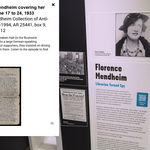Stolpersteine—Commemoration and Controversy

- Author
- Michael Simonson
- Date
- Fri, Nov 1, 2019
The Talmud states, “A person is only forgotten when his or her name is forgotten.” Today, Germany, Austria, and many other countries use engraved brass blocks in the pavement known as Stolpersteine to memorialize to individuals murdered or otherwise affected by Nazi persecution.
The Stolperstein idea was formulated by the German artist Gunter Demnig in Cologne in 1992. An artist who worked overseeing German historical monuments, Demnig developed his famous project out of an effort to memorialize the fate of Sinti and Roma deported from the Cologne railroad station to death camps in 1942. Instead of naming individuals, Demnig installed a brass plate engraved with the first lines of the deportation edict. In 1993 Demnig adapted the concept as a memorial for individuals to be placed in front of the victims’ last address before their deportation or flight.
Stolpersteine, which translates to “stumbling blocks,” have been widely praised, but they have also generated controversy. Critics argue that the stones, which are stepped on and often go unnoticed by pedestrians, demean the memory of the victims. The Jewish Community of Munich, for example, has objected to the laying of Stolpersteine, leading the city to ban them in 2015. In 2018, the city unveiled a new type of plaque that can be placed at the last address of victims.
Despite the controversy, over 70,000 Stolpersteine have been placed in over two dozen countries, and the Dr. Robert Ira Lewy Reference service still receives many inquiries from community groups and descendents working to document the last address of Holocaust victims in order to place Stolpersteine as memorials.
From LBI News No. 108
Latest News





